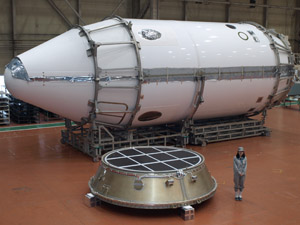H-IIB Launch Vehicle Fairing Delivered
Nov. 04, 2010

Tokyo, November 4, 2010 — Kawasaki Heavy Industries, Ltd. announced today that it has shipped a payload fairing (PLF*1) for the H-IIB Launch Vehicle No. 2 to be used by the Japan Aerospace Exploration Agency (JAXA) at its Tanegashima Space Center. After design and manufacturing of the PLF at Kawasaki's Gifu Works, the fairing was finally assembled and shipped from its Harima Works. Upon arrival at the Tanegashima Space Center, the PLF will be incorporated into the H-IIB Launch Vehicle No. 2 in preparation for the upcoming launch of JAXA’S HTV-2*2 scheduled for this winter.
The 5S-H PLF is an extended version of the five-meter single (5S) model designed for the H-IIA Launch Vehicle. It features a 15-meter-long cylinder, which is three meters longer than the 5S model, as well as a reinforced structure that is designed to withstand an increased payload weight. The 5S-H PLF will carry one HTV.
Since delivering the first PLF for the H-II launch vehicle in 1993, Kawasaki has supplied payload fairings for a total of seven H-II launch vehicles. In order to meet a broad range of payload specifications such as the launch of large satellites as well as the simultaneous launch of two satellites, Kawasaki has developed and manufactured a wide spectrum of PLFs for H-IIA launch vehicles, including four-meter single (4S), four-meter dual (4/4D), and five-meter single fairings (5S). In addition to supplying these PLFs that have been a key component in 18 different launch vehicles to date, Kawasaki has also supplied the PLF for the H-IIB Launch Vehicle No. 1.
Kawasaki is playing a vital role in today’s satellite launch industry via the development and production of cutting-edge PLFs.
Overview of PLF for H-IIB Launch Vehicle No. 2
| Type: | 5-m extended fairing (5S-H) |
| Length: | 15 m |
| Diameter: | Approximately 5.1 m |
| Payload: | HTV exclusive |
|
*1.
|
A payload fairing is an enclosure installed at the tip of a launch vehicle that protects the satellite from aerodynamic heating, acoustic noise and vibration during liftoff. After the launch vehicle leaves the earth's atmosphere, the fairing splits in two and is jettisoned, allowing the satellite to separate from the launch vehicle. |
|
*2.
|
The H-II Transfer Vehicle (HTV) is an unmanned cargo transporter developed in Japan that is designed to deliver supplies to the International Space Station. |





